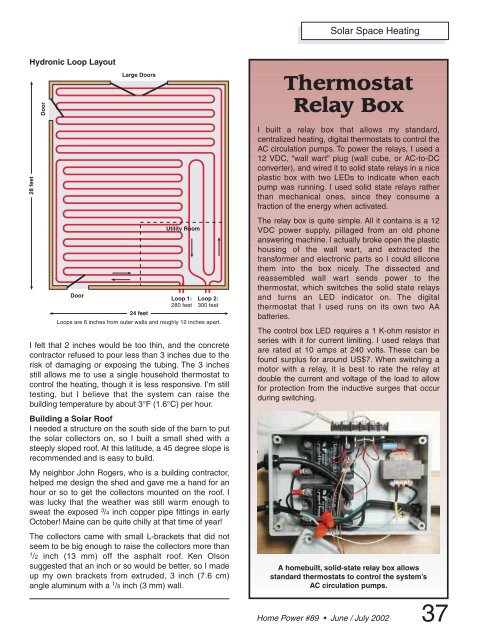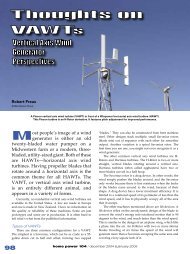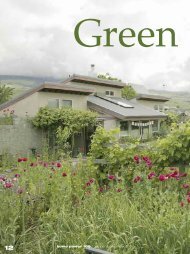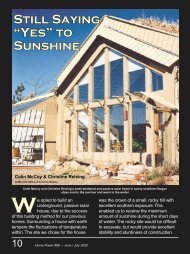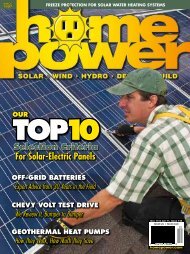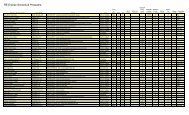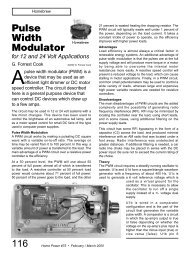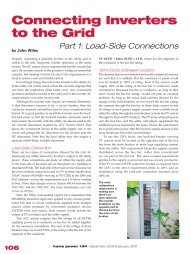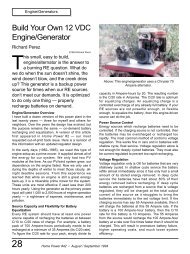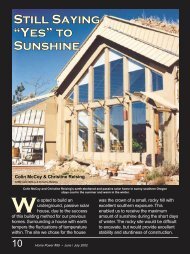Solar Heat: for My Maine Workshop - Home Power Magazine
Solar Heat: for My Maine Workshop - Home Power Magazine
Solar Heat: for My Maine Workshop - Home Power Magazine
You also want an ePaper? Increase the reach of your titles
YUMPU automatically turns print PDFs into web optimized ePapers that Google loves.
<strong>Solar</strong> Space <strong>Heat</strong>ingHydronic Loop Layout28 feetDoorLarge DoorsThermostatRelay BoxI built a relay box that allows my standard,centralized heating, digital thermostats to control theAC circulation pumps. To power the relays, I used a12 VDC, “wall wart” plug (wall cube, or AC-to-DCconverter), and wired it to solid state relays in a niceplastic box with two LEDs to indicate when eachpump was running. I used solid state relays ratherthan mechanical ones, since they consume afraction of the energy when activated.Door24 feetUtility RoomLoop 1:280 feetLoop 2:300 feetLoops are 6 inches from outer walls and roughly 12 inches apart.I felt that 2 inches would be too thin, and the concretecontractor refused to pour less than 3 inches due to therisk of damaging or exposing the tubing. The 3 inchesstill allows me to use a single household thermostat tocontrol the heating, though it is less responsive. I’m stilltesting, but I believe that the system can raise thebuilding temperature by about 3°F (1.6°C) per hour.The relay box is quite simple. All it contains is a 12VDC power supply, pillaged from an old phoneanswering machine. I actually broke open the plastichousing of the wall wart, and extracted thetrans<strong>for</strong>mer and electronic parts so I could siliconethem into the box nicely. The dissected andreassembled wall wart sends power to thethermostat, which switches the solid state relaysand turns an LED indicator on. The digitalthermostat that I used runs on its own two AAbatteries.The control box LED requires a 1 K-ohm resistor inseries with it <strong>for</strong> current limiting. I used relays thatare rated at 10 amps at 240 volts. These can befound surplus <strong>for</strong> around US$7. When switching amotor with a relay, it is best to rate the relay atdouble the current and voltage of the load to allow<strong>for</strong> protection from the inductive surges that occurduring switching.Building a <strong>Solar</strong> RoofI needed a structure on the south side of the barn to putthe solar collectors on, so I built a small shed with asteeply sloped roof. At this latitude, a 45 degree slope isrecommended and is easy to build.<strong>My</strong> neighbor John Rogers, who is a building contractor,helped me design the shed and gave me a hand <strong>for</strong> anhour or so to get the collectors mounted on the roof. Iwas lucky that the weather was still warm enough tosweat the exposed 3 /4 inch copper pipe fittings in earlyOctober! <strong>Maine</strong> can be quite chilly at that time of year!The collectors came with small L-brackets that did notseem to be big enough to raise the collectors more than1 /2 inch (13 mm) off the asphalt roof. Ken Olsonsuggested that an inch or so would be better, so I madeup my own brackets from extruded, 3 inch (7.6 cm)angle aluminum with a 1 /8 inch (3 mm) wall.A homebuilt, solid-state relay box allowsstandard thermostats to control the system’sAC circulation pumps.<strong>Home</strong> <strong>Power</strong> #89 • June / July 200237


